Here are your stories for today...
Be safe out there!
Tom
Skydiving Plane With 15 Aboard Crashes During Takeoff At New Jersey Airport; FAA Probes Incident
The incident occurred around 5:30 p.m. local time when a Cessna 208B aircraft was departing from the airport, the US Federal Aviation Administration (FAA) said in a statement to Fox News Digital.
New Jersey: A skydiving aircraft carrying 15 people crashed after overshooting the runway during takeoff at Cross Keys Airport in Monroe Township, New Jersey, on Wednesday evening, officials said.
people crashed after overshooting the runway during takeoff at Cross Keys Airport in Monroe Township, New Jersey, on Wednesday evening, officials said.
The incident occurred around 5:30 p.m. local time when a Cessna 208B aircraft was departing from the airport, the US Federal Aviation Administration (FAA) said in a statement to Fox News Digital.
According to the FAA, the aircraft was being used for skydiving purposes and had 15 individuals on board at the time of the crash, Fox News reported.
Gloucester County Emergency Management described the incident as a "mass casualty incident" at the airport.
Hospital authorities said five injured individuals were expected to be transported to Cooper University Hospital in Camden. The update was shared by Wendy Marano, spokesperson for the hospital, to Fox Philadelphia.
Further details are awaited, and the FAA has initiated an investigation into the cause of the crash.
https://www.freepressjournal.in/world/skydiving-plane-with-15-aboard-crashes-during-takeoff-at-new-jersey-airport-faa-probes-incident
One dead in Sumner County plane crash as federal investigation unfolds. Everything we know
Katie Nixon - Nashville Tennessean
Multiple agencies are responding to a plane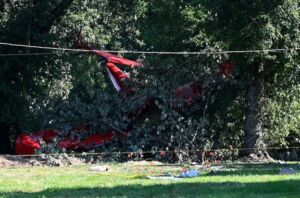 crash in Sumner County, Emergency Medical Services Public Information Officer Jackson Boyd confirmed to The Tennessean.
crash in Sumner County, Emergency Medical Services Public Information Officer Jackson Boyd confirmed to The Tennessean.
According to the Federal Aviation Administration, an ERCO Ercoupe crashed in a Gallatin field around 1 p.m. on July 2.
Preliminary reports indicate the crash happened at Collier Lane and Highway 25, which has a Gallatin address but is considered in the Cottontown area.
One person has died, officials say.
"Only the pilot was on board," A Federal Aviation Administration spokesperson said.
"The plane departed from Hopkinsville-Christian County Airport in Kentucky and was headed to Cleveland Regional Jetport in Tennessee. The FAA and National Transportation Safety Board will investigate. The NTSB will lead the investigation and provide any updates," the spokesperson said.
Sumner County Sheriff Eric Craddock said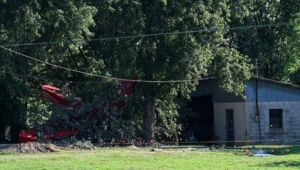 first responders are asking the public to "avoid the area to allow emergency responders and investigators to safely complete their work."
first responders are asking the public to "avoid the area to allow emergency responders and investigators to safely complete their work."
Craddock confirmed the department's response in a text message.
"The Sumner County Sheriff’s Office has responded to the scene of a fatal plane crash that occurred earlier today in the Cottontown, Tennessee area. Our deputies and emergency personnel were quickly on site to secure the area and assist in the initial response," Craddock said.
"At this time, we are actively working alongside the Federal Aviation Administration and the National Transportation Safety Board, who will likely assume the lead role in the investigation moving forward. Our thoughts and prayers are with the families affected by this tragic incident."
Wing flap from plane found in Raleigh driveway, FAA investigating link to Delta flight
The Federal Aviation Administration is investigating after a piece of an airplane was found blocking a Raleigh driveway on Wednesday morning.
By WRAL staff
The Federal Aviation Administration (FAA) is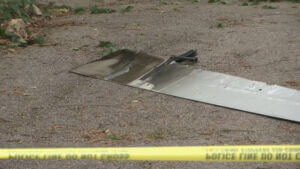 investigating after part of an airplane was found blocking a Raleigh driveway.
investigating after part of an airplane was found blocking a Raleigh driveway.
Around 8:30 a.m. on Wednesday, Raleigh police officers responded to a home on Banbury Road, near Wade Avenue, where a 911 caller reported the airplane part was blocking a driveway.
The FAA confirmed that a wing flap from Delta flight 3247 that left Hartsfield–Jackson Atlanta International Airport was missing upon landing at Raleigh-Durham International Airport. The agency is working to confirm the flap found in the driveway belongs to that plane. The flight arrived at RDU around 1:15 a.m. on Wednesday.
The flap is believed to have belonged to a Boeing 737. There were 109 passengers and six crew members on board.
"A portion of the left wing's trailing edge flap evidently separated from the aircraft prior to its safe landing," said Delta spokesperson Samantha Facteau. "After the aircraft landed safely, it was observed that a portion of the left wing's trailing edge flap was not in place. Delta is fully supporting retrieval efforts and will cooperate with investigations as nothing is more important than safety."
There were no reports of injuries or property damage, and there was no evidence of a plane crash, according to Raleigh police.
"It's amazing when you consider it's such a dense neighborhood and people are out all the time," said Susan Reed, who works near the area where the part landed. "We really dodged a bullet on this one. Let's just hope it doesn't happen again."
The part was removed from the driveway around 12:30 p.m.
"You can land an aircraft with this component missing and land it safely," said James Crouse, a lawyer who specializes in aviation accidents.
https://www.wral.com/news/local/airplane-part-blocks-raleigh-driveway-july-2025/
Small plane crashes at SWF; no one injured
By Hank Gross
STEWART AIRPORT – A small single-engine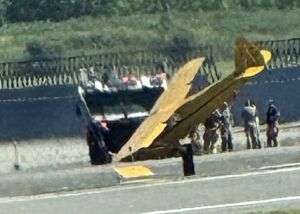 plane departing New York Stewart International Airport crashed nose-first shortly after takeoff just after 3 p.m. on Wednesday.
plane departing New York Stewart International Airport crashed nose-first shortly after takeoff just after 3 p.m. on Wednesday.
Two people were on board, were evaluated at the scene, with no injuries reported and no medical transport was required, authorities said.
Emergency crews from Town of Newburgh EMS and Air National Guard Aircraft Rescue and Fire Fighting responded to the scene immediately.
There was no fire and the airport was closed for about 40 minutes.
The FAA is investigating the cause of the crash.
NTSB Prelim: Piper PA-23
Pilot Also Reported That Due To A Fuel Leak, The Auxiliary Fuel Tanks Were Not Used
Location: Palm Bay, FL Accident Number: ERA25LA217
Date & Time: June 4, 2025, 13:41 Local Registration: N2109P
Aircraft: Piper PA-23 Injuries: 1 Minor, 1 None
Flight Conducted Under: Part 91: General aviation - Personal
On June 4, 2025, at 13:41 eastern daylight time, a Piper PA-23, N2109P, was substantially damaged when it was involved in an accident near Palm Bay, Florida. The commercial pilot was uninjured, and the sole passenger received minor injuries. The airplane was operated as a Title 14 Code of Federal Regulations Part 91 personal flight.
According to the pilot, they had departed in the morning from the Front Royal-Warren County Airport (FRR), Front Royal, Virginia, and were heading to Boca Raton, Florida. The pilot reported that prior to departing FRR, they had filled both main fuel tanks for a total of 72 gallons of fuel. The pilot also reported that due to a fuel leak, the auxiliary fuel tanks were not used. During the flight, the pilot made a fuel stop at the Orangeburg Municipal Airport (OGB), Orangeburg, South Carolina, where they took on 60.3 gallons of fuel to top off the main fuel tanks. After departing OGB, the flight continued south. When the flight approached Savannah, Georgia, the pilot reported encountering a patch of weather and diverted to the west to go around it. After passing the weather, the pilot began to follow the coastline, and as the airplane approached the Daytona Beach area, the pilot diverted to the east to avoid another patch of weather.
Shortly afterward, the pilot began to make an approach to their next fuel stop at the Valkaria Airport (X59), Valkaria, Florida. While on approach to X59, the pilot reported entering a “massive rain shower,” and the pilot lost sight of the runway. The pilot aborted the approach and initiated a climb toward the east to exit the weather. After reaching about 1,500 ft mean sea level (msl), the pilot reported that the left engine began to sputter and lost power. The pilot applied carburetor heat and attempted to restart the left engine; however, engine power did not return. The pilot then reported that the right engine began to sputter, and the pilot elected to perform a forced ditching into the Indian River near Palm Bay, Florida. During the ditching, the airplane sustained substantial damage to the fuselage and empennage. The pilot and passenger exited the airplane and swam to shore.
The wreckage was recovered the same day from the river and brought to shore. The following day, the wreckage was examined. Both fuel selectors were found in the “MAIN” fuel tank position. The left main and auxiliary fuel tank caps were found to be secure, and there were no signs of a fuel leak around the fuel tanks. The left main fuel tank was drained at the left fuel strainer bowl, where approximately 7 gallons of water were drained from the fuel tank. There were no signs of fuel in the left main fuel tank. The left auxiliary fuel tank was drained at the strainer, and the tank contained approximately 4 gallons of fuel that had the odor and color consistent with 100 low lead (LL) aviation gasoline; there was no water found in the left auxiliary fuel tank. The left fuel strainer bowl was removed and visually inspected; the strainer bowl cap was found to be severely corroded. There was no fuel screen installed in the left fuel strainer, and the bowl contained several large pieces of corroded debris.
The right main fuel tank cap was found to be secured to the fuel tank filler and sealed properly. The right auxiliary fuel tank cap was found installed in the right auxiliary tank filler; however, the right auxiliary tank filler neck was missing the metal ring insert and would not seal properly. A lighted borescope was inserted into the right auxiliary fuel tank, and the filler port insert was found near the right auxiliary tank pickup screen. The right main fuel tank was drained at the fuel strainer, where approximately 1 gallon of water and 4 gallons of fuel that had the odor and color consistent with 100LL aviation gasoline were drained from the fuel tank. The right auxiliary fuel tank was found to be completely devoid of fluid.
The wreckage was retained for further examination
FMI: www.ntsb.gov
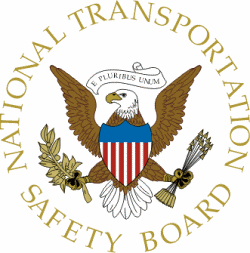
Today in History
37 Years ago today: On 3 July 1988 Iran Air flight IR655, an Airbus A300, was shot down by a US Navy frigate and crashed into the Strait of Hormuz off Qeshm Island, Iran, killing all 290 occupants.
| Date: | Sunday 3 July 1988 |
| Time: | 10:24 |
| Type: | Airbus A300B2-203 |
| Owner/operator: | Iran Air |
| Registration: | EP-IBU |
| MSN: | 186 |
| Year of manufacture: | 1982 |
| Total airframe hrs: | 11497 hours |
| Engine model: | General Electric CF6-50C2 |
| Fatalities: | Fatalities: 290 / Occupants: 290 |
| Other fatalities: | 0 |
| Aircraft damage: | Destroyed, written off |
| Category: | Unlawful Interference |
| Location: | 4 km SE off Qeshm Island - Iran |
| Phase: | En route |
| Nature: | Passenger - Scheduled |
| Departure airport: | Bandar Abbas Airport (BND/OIKB) |
| Destination airport: | Dubai Airport (DXB/OMDB) |
| Investigating agency: | ICAO |
| Confidence Rating: | Accident investigation report completed and information captured |
Narrative:
Iran Air flight IR655, an Airbus A300, was shot down by a US Navy frigate and crashed into the Strait of Hormuz off Qeshm Island, Iran, killing all 290 occupants.
Iran Air flight 451 arrived at Bandar Abbas (BND) from Tehran (THR) at 08:40. The Airbus A300 was to continue to Dubai (DXB) as flight 655. Prior to departure the crew received an enroute clearance to Dubai via the flight planned route A59 and A59W at FL140. The flight took off from runway 21 at 10:17 hours and climbed straight ahead.
Two minutes later, the crew reported leaving 3500 feet for FL140 on Airway A59, estimating MOBET at 06:53 UTC (10:23 Iran time). At 10:24:00 the aircraft passed MOBET out of FL120. At 10:24:43 the Airbus was hit by surface-to-air missiles. The tail and one wing broke off as a result of the explosions. Control was lost and the aircraft crashed into the sea.
The missiles were fired by the US Navy cruiser USS Vincennes. It was operating in the area together with the frigates USS Elmer Montgommery and USS John H. Sides. They were to protect other ships in the area.
At about the time the Airbus took off, the radar aboard the USS Vincennes picked up a brief IFF mode 2 response, which led to the mistaken identification of the Airbus as a hostile F-14 aircraft. The USS Vincennes issued 7 challenges on the Military Air Distress (MAD) frequency 243 MHz, addressed to 'Iranian aircraft', 'Iranian fighter' or 'Iranian F-14'. These messages were followed by three challenges on the IAD (International Air Defence) radio frequency.
Due to increasing tension in the area - on May 17, 1987 an Iraqi Mirage had attacked USS Stark - all aircraft in the area had to monitor 121.5 Mhz: the International Air Defence - IAD radio frequency. There was no response.
Meanwhile radar operators were monitoring the Aegis screens. They reported that the incoming plane was descending with an increasing speed. In fact, the Airbus was climbing. Considering itself and USS Montgomery under aggression, USS Vincennes took the ultimate decision to launch missiles against the perceived hostile target at 10:24:22.
It remains uncertain whether the IR655 flight crew (only able to monitor the IAD, not the MAD frequencies) would have been able to rapidly identify their flight as the subject of the challenges made by the USS Vincennes.
CAUSES: "The aircraft was perceived as a military aircraft with hostile intentions and was destroyed by two surface-to-air missiles ."
